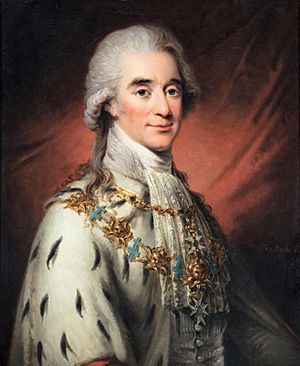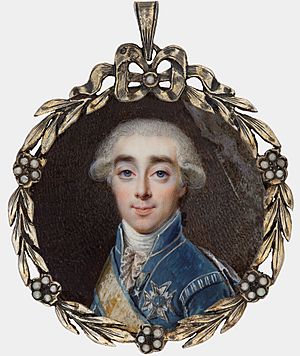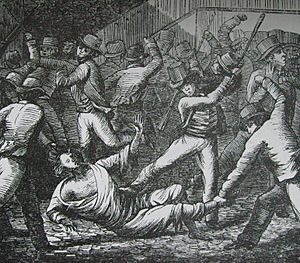Axel von Fersen the Younger facts for kids
Quick facts for kids
His Excellency the Right Honourable
Count Axel von Fersen
|
|
|---|---|

Count Axel von Fersen, dressed in the robes of a Swedish Privy Councilor, with various chivalric medals
|
|
| Marshal of the Realm | |
| In office 1801–1810 |
|
| Lord of the Realm | |
| In office 1799–1810 |
|
| Minister to the King of France | |
| In office 1790–1793 |
|
| Minister to the Emperor of Austria | |
| In office 1791–1791 |
|
| Minister to the Second Congress of Rastatt | |
| In office 1797–1798 |
|
| Chancellor of Uppsala University | |
| In office 1799–1810 |
|
| Personal details | |
| Born |
Hans Axel von Fersen
4 September 1755 Stockholm, Sweden |
| Died | 20 June 1810 (aged 54) Stockholm, Sweden |
| Resting place | Ljungs kyrka, Östergötland |
| Parents | Count Axel von Fersen the Elder Hedvig Catharina De la Gardie |
| Military service | |
| Branch/service | Swedish Army French Army |
| Years of service | 1770–1810 1770–1790 |
| Rank | Mestre de camp propriétaire of Régiment Royal-Suédois (France) General of Horse (Sweden) |
| Battles/wars | |
| Awards | Knight of the Order of the Sword, 1781 Member of the Society of the Cincinnati, 1783 Member of the Institution of Military Merit, 1786 Knight Commander of the Order of the Sword, 1791 Knight Commander Grand Cross of the Order of the Sword, 1798 Knight of the Royal Order of the Seraphim, 1800. |
Hans Axel von Fersen (born September 4, 1755 – died June 20, 1810) was a Swedish count and a very important person in Sweden's government and army. He was known as Axel de Fersen in France. He served as a Marshal of the Realm of Sweden and a General in the Swedish Army. He was also a diplomat and a close friend of Queen Marie Antoinette of France. Sadly, he died in Stockholm during a public event.
Contents
Axel von Fersen's Life Story
Early Life and Family
Axel von Fersen was born in 1755. His father was Axel von Fersen the Elder, a Field Marshal and a very powerful politician in Sweden. His mother was Countess Hedvig Catharina De la Gardie. Axel had two sisters, Hedvig Eleonora and Eva Sophie, and one brother, Fabian Reinhold.
His family, the Fersens, came from Estonia to Sweden during the Thirty Years' War (1618-1648). They became famous during the reigns of Swedish Queens and Kings. In 1735, his family bought Steninge Palace, a grand house near Stockholm.
Axel's father was one of the richest men in Sweden. He owned several large estates, mines, forests, and a big part of Sweden's East India Company. Axel grew up learning many languages like French, Latin, English, German, and Italian. He also received a military education.
Adventures in Europe
In 1770, Axel von Fersen began a long journey through Europe. He wanted to see the world and finish his military studies. He visited military academies in places like Brunswick and Turin.
In 1771, he met the famous philosopher Voltaire in Switzerland. Axel was impressed by Voltaire's sharp mind. In 1774, he traveled to France and met King Louis XV. A week later, he met Marie-Antoinette, who was then the future Queen of France. She spoke to him for a long time.
After visiting England and meeting King George III, Axel returned to Sweden in 1775. He served under King Gustavus III for about three years.
Close Friend of Marie-Antoinette
In 1778, Axel von Fersen returned to France. He met the French royal family again. Queen Marie-Antoinette remembered him and was very kind. She often invited him to her private parties at the Petit Trianon, a special place on the grounds of the Palace of Versailles.
At the Petit Trianon, the Queen liked to keep things simple and friendly. Her guests were treated equally. Axel became a very close friend of the Queen. Their friendship was well-known at court.
Helping America in War
In the 1770s, the American Revolutionary War began. France decided to help the American rebels against Great Britain. In 1780, Axel von Fersen became an aide to General Rochambeau, a French commander. He sailed to North America.
In September 1780, Axel met American General George Washington in Connecticut. He described Washington as a hero, quiet but polite. Axel and the French army joined Washington's forces.
In 1781, they marched to link up with Washington's army. Axel helped deliver important messages. The French and American forces surrounded the British at Yorktown. The British surrendered, which helped end the war. Axel returned to France in 1783.
Life Before the French Revolution
After the war, Axel von Fersen received an award from George Washington, the Order of Cincinnatus. However, his own king did not allow him to wear it.
King Gustavus III of Sweden asked Axel to join him in Germany. Axel was promoted in the Swedish army. He also became a colonel in a French army regiment. In 1784, Axel returned to Versailles with King Gustavus. He sat with Marie-Antoinette at a royal event. He even got a dog for the Queen, which she named Odin.
Axel divided his time between Paris, Versailles, and his regiment. During this time, France faced many financial problems. People started to discuss changes in the government.
The French Revolution Begins
In 1787, Axel von Fersen became a secret envoy for the Swedish King to the King and Queen of France. He moved closer to Paris to be able to help.
By 1788, people in France were talking a lot about a new constitution. Axel noticed that everyone, even servants, was reading pamphlets about political changes.
In May 1789, the Estates-General met. This was a big meeting of different groups in France. Soon, the Third Estate, representing common people, formed the National Assembly. The monarchy brought troops to Paris, which made people nervous.
On July 14, 1789, the Bastille prison was stormed. This was a major event in the French Revolution. Axel was at Versailles with the King and Queen, discussing what to do. The King decided to go to Paris to show goodwill. Axel followed him and saw the King accept the national symbol from the mayor.
As the revolution spread, riots happened in many cities. Axel wrote about how the King's power was disappearing. In October 1789, a large crowd marched to Versailles. They entered the royal apartments. The King and Queen were forced to agree to return to Paris. Axel witnessed this sad event and traveled back to Paris with the royal family.
A Daring Escape Attempt
By 1791, the royal family's situation was very difficult. Axel von Fersen helped plan their escape from Paris. He got a special carriage and arranged for the escape on June 20.
Late at night, the royal children, the King's sister, and King Louis XVI left secretly. Marie-Antoinette joined them a bit later. Axel himself drove the carriage away from Paris. They changed carriages and continued their journey.
However, the royal family was discovered in Varennes on June 22. They were stopped and held until troops arrived. They were then brought back to Paris. This escape attempt failed, and it made their situation even worse.
After the Revolution
After the failed escape, a warrant was issued for Axel's arrest. He left France and tried to convince other European countries to declare war on France to help the royal family. He even used a secret writing method with milk to communicate with Marie-Antoinette.
In 1791, he met Marie-Antoinette's brother, Emperor Leopold, to discuss the situation. A declaration was issued, supporting King Louis XVI, but it didn't lead to immediate war.
Axel tried to plan another escape for the royal family. He traveled to Paris in disguise. He met with Marie-Antoinette and King Louis. However, the King felt it was too late and that another escape would not work. This was the last time Axel saw the King and Queen.
In March 1792, King Gustav III of Sweden was shot and died. His brother became regent. In April, France declared war on Austria. The situation for the French royal family became very dangerous.
On January 21, 1793, King Louis XVI was executed. Axel heard the news and was very sad. On October 16, Marie-Antoinette was also executed. Axel was heartbroken by this news.
His Final Years and Death
Axel von Fersen returned to Sweden. For a time, he was suspected of being involved in a plot against the regent, so he lost his diplomatic jobs. But when Gustav IV Adolf became King in 1796, Axel was back in favor. He became a trusted advisor to the young king.
In 1797, Axel met Napoleon Bonaparte at a meeting in Germany. Napoleon was not happy with Sweden's actions and spoke strongly to Axel. Axel remained calm and simply said he would tell his King what he heard.
In 1799, Axel was appointed as one of the Lords of the Realm in Sweden. He also became the Chancellor of Uppsala University. This was a big job, especially since there were some people at the university who supported the French Revolution. Axel helped calm things down there.
In 1801, Axel von Fersen became the Marshal of the Realm, the highest official in the Swedish court after the King. His sister, Sophie, came to live with him and manage his household.
In 1809, King Gustavus IV was overthrown. There was a big disagreement about who should be the next ruler. Axel von Fersen supported the King's son. However, the popular Crown Prince Charles August was also a candidate.
On May 28, 1810, Crown Prince Charles August died suddenly. Rumors spread that he had been poisoned, and Axel von Fersen and his sister were wrongly suspected. They received death threats.
On June 20, 1810, during the Crown Prince's funeral procession, Axel von Fersen was in a carriage. An angry crowd attacked his carriage. They broke the windows and pulled him out. Despite efforts to protect him, the crowd became very violent. Axel von Fersen died from the injuries he received from the mob.
A few months later, Axel von Fersen and his family were cleared of any wrongdoing in the Crown Prince's death. He received a proper state burial. His sister, Sophie Piper, built a memorial to him at her home. The inscription on it speaks of his courage and clear conscience in his final moments.
Friendship with Marie-Antoinette
Axel von Fersen was very popular at the French court. He was known for his charm and wit. Queen Marie-Antoinette, who first met him when they were both 18, was especially drawn to him. Their friendship grew strong during his second visit to France in 1778. She invited him to her private gatherings, and he became part of her trusted circle. Their close friendship was well-known. Axel went to fight in the American war in 1780, partly to avoid any scandal because of their closeness. After he returned in 1783, he was again welcomed into the Queen's private group. He remained a loyal and devoted friend to her throughout her life, especially during the difficult times of the French Revolution.
See also
 In Spanish: Hans Axel de Fersen para niños
In Spanish: Hans Axel de Fersen para niños




